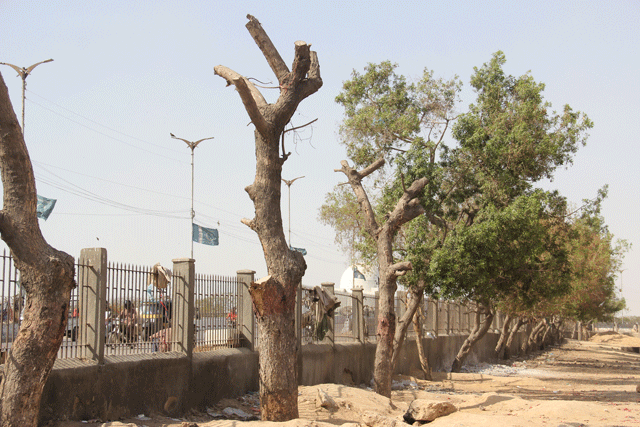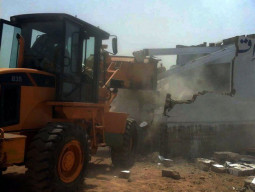
Thanks to the construction of the Green Line Bus Rapid Transit (BRT), the concrete structure will be running over the corpses of as many as 7,321 trees.
The contractors of the project were supposed to replant over 800 of these trees last year in the month of July in the premises of Mazar-e-Quaid. They were able to transplant only 12 in a football ground near Mazar-e-Quaid, said a civil engineer at Quaid-e-Azam Mazar Management Board, Jawad Mughal.
Out of those 12, he pointed out, hardly four survived. The transplantation activity, he said, occurred last year in the month of August and the authorities dedicated not more than two days for the care of the trees.
Fate of almost 12,000 trees uncertain
“The contractors had assured that for two years, they would be taking care of the trees,” said Mughal. “However, no one turned up the third day after transplantation.”
He added there was already water shortage in the area and no one was there to water the transplanted trees, which was why only four survived. He believes the survival of even these four trees is no less than a miracle.
The Green Line BRT will run on segregated lanes from Surjani Town to Saddar. For a city severely lacking mass transit, the Green Line offers a much-needed respite. However, it comes at the cost of nearly all the greenbelts in District Central.
From Nagan Chowrangi onwards, the Green Line will run on the median – the central greenbelt of the road — once lined with thousands of trees. Even at Gurumandir, the Green Line has trampled over some trees that date back to before Partition.
Out of the 7,321 trees that have been removed for the construction of the Green Line, 6,321 are Conocarpus and Eucalyptus, according to the Landscape Architecture Studio’s principal landscape architect, Komal Parvez.
She added that these trees have already been banned by the Karachi Metropolitan Corporation (KMC) as they harmed invasive plant species.
Tree cutting: Mourning the loss of the young Neems
The Studio, which numbered the trees to be chopped down, has been hired as consultants by the Karachi Infrastructure Development Company Limited (KIDCL), which is managing the Green Line’s construction.
According to the Studio’s survey conducted around two years back, there were 23 chandi, 51 neem, 33 ficus, 18 date palm, 33 burna, 300 bhindi and 318 lignum trees on the Green Line BRT’s track.
However, the track from Karachi Development Authority (KDA) Chowrangi till Board Office Chowrangi and the one from Nazimabad till Lasbela had 400 and 600 trees, respectively. Species of these are not available.
Former KIDCL chief financial officer Bilal Memon had told The Express Tribune earlier that apart from the transplantation, the Green Line contractors plan to plant 19,500 new trees, estimated to cost Rs88 million.
Urban heat island
The timing of the plantation of new trees and transplantation of the older ones does not sit well with environmentalist Dr Zafar Iqbal Shams. The identified trees, he said, should have been transplanted before commencing the project.
He pointed out that in order to pave way for the Green Line BRT, thousands of small and huge trees have already been chopped off without planting new ones. With summer round the corner, this, he said, will result in much harsher weather conditions than before.
Green Line bus to make Karachi less green
“Every tree counts,” said horticulturist Tofiq Pasha. “For the Green Line BRT, it is a matter of thousands of trees. Imagine what impact it will create on the environment.”
According to Shams, the jungle of concrete buildings absorbs the heat from sun and enhances the temperature by at least five to seven degrees when they release that heat. The process is known as ‘urban heat island’.
In such a case, he explained, the trees in the surroundings keep the concrete structures cooler and reduce the effects of urban heat island. Now, he said, with thousands of trees completely uprooted, this urban heat island phenomenon can be far deadlier than that of the heat wave – a natural process that struck the port city two years back.
However, according to architect Pervez, the heat island effect has been in the city much before work on the Green Line BRT kicked off. She said they kept the number of trees to be transplanted at 800 but if some of those trees are not obstructing construction work, they will not be removed.
Meanwhile, KIDCL’s chief engineer pointed out that apart from Mazar-e-Quaid, 77 trees were transplanted in a school near Anda Mor in North Karachi. Responding to the situation, District Municipal Corporation Central chairman Rehan Hashmi said he will pursue litigation against the KIDCL’s environmental plunder.
In their Environmental Impact Assessment (EIA) report, he pointed out, the KIDCL had promised to plant 17,000 new trees, for which Rs150 million were allocated.
They also promised to look after the trees for two years, he added. “Now they are reluctant to do their job and their consultants for the transplantation have also gone.”


1732243059-0/mac-miller-(2)1732243059-0-165x106.webp)

1672385156-0/Andrew-Tate-(1)1672385156-0-165x106.webp)












COMMENTS (1)
Comments are moderated and generally will be posted if they are on-topic and not abusive.
For more information, please see our Comments FAQ